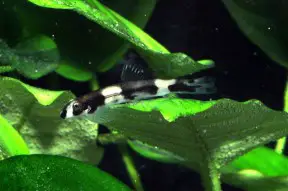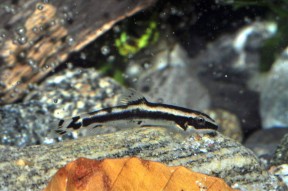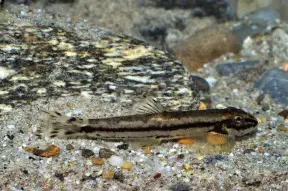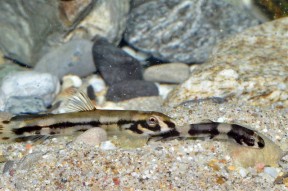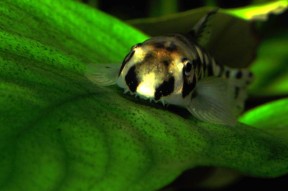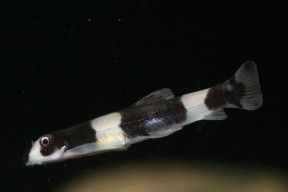Yaoshania pachychilus
Panda Loach
SynonymsTop ↑
Protomyzon pachychilus Chen 1980
Etymology
Yaoshania: named for the Dayaoshan, the mountain from where the type species was discovered.
Classification
Order: Cypriniformes Family: Balitoridae
Distribution
Officially known only from a handful of headwater tributary streams draining the Dayao Mountain (Dayaoshan) in Jinxiu County, Guangxi Zhuang Autonomous Region, southern China.
There are just three confirmed localities of which two drain into the Liu River (Liujiang) and one the Gui River (Guijiang), themselves both north bank tributaries of the much larger Pearl River (Zhujiang) system.
It remains unclear if the fish in the aquarium trade are collected from one of the above, one of which lies within a protected forest park, or there exist undisclosed, additional locations though the latter possibility appears likely (Z. Hang, pers. comm.).
The IUCN currently list it as ‘Least Concern’ but a report by Kong et al. (2008) suggests the overall population to be small and habitats under threat of degradation from dam construction, loss of water quality and the use of electrofishing and ichthyotoxins.
Habitat
A demersal species restricted to shallow, seasonal, fast-flowing, headwaters and minor tributaries characterised by stretches of riffles and runs broken up by pools or cascades in some cases.
Substrates are normally composed of smaller rocks, sand and gravel with jumbles of boulders, and while riparian vegetation and patches of submerged leaf litter are common features aquatic plants probably aren’t present.
The most favourable habitats are in excess of 500 metres AMSL and contain crystalline, oxygen-saturated water which helps promote development of a biofilm layer carpeting submerged surfaces.
Water depth is typically 50 cm or less, although during periods of high rainfall they may be temporarily turbid due to suspended material dislodged as a result of increased flow rate and water depth.
In at least one habitat Y. pachychilus occurs syntopically with Vanmanenia pingchowensis with Erromyzon sinensis inhabiting lower reaches of the same stream.
Maximum Standard Length
50 – 60 mm.
Aquarium SizeTop ↑
A tank with base dimensions of 60 ∗ 30 cm is big enough to house a small group. Though often marketed as such, this species isn’t suitable for tiny ‘nano’ aquaria.
Maintenance
Most importantly the water must be clean and well-oxygenated so we suggest the use of an over-sized filter as a minimum requirement.
Turnover should ideally be in excess of 15-20 times per hour so additional powerheads, airstones, etc., should be employed to achieve the desired flow and oxygenation if necessary.
Base substrate can either be of gravel, sand or a mixture of both to which should be added a layer of water-worn rocks and pebbles of varying sizes.
Aged driftwood can also be used but avoid new pieces since these usually leach tannins which discolour the water and reduce the effectiveness of artificial lighting, an unwanted side-effect since the latter should be strong to promote the growth of algae and associated microorganisms.
Exposed filter sponges will also be grazed, and some balitorid enthusiasts maintain an open filter in the tank specifically to provide an additional food source.
Although rarely a feature of the natural habitat aquatic plants can be used with adaptable genera such as Microsorum, Crinum and Anubias spp. likely to fare best.
The latter are particularly useful as their leaves tend to attract algal growth and provide additional cover.
Since it needs stable water conditions and feeds on biofilm this species should never be added to a biologically immature set-up, and a tightly-fitting cover is necessary since it can literally climb glass.
While regular partial water changes are essential aufwuchs can be allowed to grow on all surfaces except perhaps the viewing pane.
Water Conditions
Temperature: Its natural waters lie in a humid, subtropical region where air temperatures rarely drop below 60°F/15.5°C and may be much higher in summer. For general care 68 – 75°F/20 – 23.9°C is therefore recommended but it should withstand warmer conditions on a temporary basis provided dissolved oxygen levels are sufficiently high.
pH: 6.5 – 7.5
Hardness: 36 – 268 ppm
Diet
Much of the natural diet is likely to be composed of benthic algae plus associated micro-organisms.
In captivity it will accept good-quality dried foods and meatier items like live or frozen bloodworm but may suffer internal problems if the diet contains excessive protein.
Home-made foods using a mixture of natural ingredients bound with gelatin are very useful since they can be tailored to contain a high proportion of fresh vegetables, Spirulina and similar ingredients.
For long-term success it’s best to provide a mature aquarium with a plentiful supply of algae-covered rocks and other surfaces.
If unable to grow sufficient algae in the main tank or you have a community containing numerous herbivorous fishes which consume what’s available quickly it may be necessary to maintain a separate tank in which to grow algae on rocks and switch them with those in the main tank on a cyclical basis.
Such a ‘nursery‘ doesn’t have to be very large, requires only strong lighting and in sunny climates can be kept outdoors. Algal type is also important with diatoms and softer, green varieties preferred to tougher ones like rhodophytic ‘black brush’ algae.
Balitorids are often seen on sale in an emaciated state which can be difficult to correct.
A good dealer will have done something about this prior to sale but if you decide to take a chance with severely weakened specimens they’ll initially require a continual, easily-obtainable source of suitable foods in the absence of competitors if they’re to recover.
Behaviour and CompatibilityTop ↑
Not an aggressive fish although its environmental requirements somewhat limit the selection of suitable tankmates.
Species inhabiting similar habitats in nature include Barilius, Discherodontus, Garra, Devario, some Rasbora, Rhinogobius, Sicyopterus and Stiphodon gobies, plus catfishes like Glyptothorax, Akysis and Oreoglanis spp.
Many loaches from the families Nemacheilidae and Balitoridae are also suitable but research your choices before purchase in order to be sure as some are excessively aggressive or otherwise competitive.
Y. pachychilus tends to exist in loose aggregations in nature so buy a group of 4 or more if you want to see their most interesting behaviour.
It’s territorial to an extent with some individuals appearing more protective of their space than others, often a prime feeding spot.
Sexual Dimorphism
Undocumented as far as we’re aware but larger, heavier-bodied individuals are likely to be female.
Reproduction
Unrecorded in captivity and little is known of its natural reproductive cycle.
NotesTop ↑
Juvenile specimens were first exported for the aquarium hobby during 2009 and have since been available on a sporadic basis with prices generally reflecting its rarity and, hopefully, number of specimens being collected.
The striking black-and-white-striped juvenile colour pattern inspired the vernacular name although it’s sometimes labelled as ‘panda goby’ rather than ‘panda loach’.
In older individuals the broad, blackish vertical bars become paler and anastomose to an extent, forming a variable network of stripes and blotches more-or-less arranged in three lateral rows; one running along the dorsal surface of the fish, one at midbody and another lower but above the origins of the pelvic, ventral and anal fins.
Adults are thus comparatively plain in appearance meaning only young fish tend to be traded.
This species was initially included in the genus Protomyzon where it remained until 2004 when Kottelat found sufficient geographical and morphological differences between members of the group inhabiting the island of Borneo and those from mainland China to warrant their separation.
The genus Erromyzon was thus erected to accommodate the mainland fishes of which there currently exist four described species, while the Bornean representatives were retained in Protomyzon.
Since Y. pachychilus does not occur in Borneo it could not be included in Protomyzon but Kottelat could not conclusively assign it to Erromyzon either because he was unable to examine any specimens during his research and it was not until 2012 that Yang et al. erected the new genus Yaoshania to accommodate it.
Yaoshania is distinguished from related genera by possession of a unique enlarged lip lamina at the corners of the mouth, connecting the upper lip and maxillary. The lamina is a flange of skin originating under the lateral part of the upper lip and continuous with the maxillary barbel (Yang et al. 2012).
Other characters useful to diagnose the genus, but not unique to it are: gill opening large, with the ventral extremity reaching lower extremity of pectoral-fin base; upper lip and rostral fold separated by a groove, rostral fold with four notches to accommodate rostral barbels; two pairs of rostral barbels and one pair of maxillary barbels; a small fleshy lobe present posterior to each maxillary barbel; pectoral fin with one simple and 17–18 branched rays; pelvic fin with one simple and 8–9 branched rays; side of body lacking vertical blotches in adult; 71–75 scales in the lateral line.
Y. pachychilus is a exclusively benthic with morphology specialised to life in fast-flowing water, i.e., the paired fins are orientated horizontally, body and head flattened. These features form a powerful sucking cup which allows the fish to cling tightly to solid surfaces.
The ability to swim in open water is greatly reduced and they instead ‘crawl’ and ‘hop’ their way across rocks, an interesting behaviour to observe in aquaria.
Yang, et al. (2012) placed the new genus in the family Balitoridae.
References
- Chen, Y.-Y., 1980 - Acta Hydrobiologica Sinica 7(1): 95-120
Systematic studies of the fishes of the family Homalopteridae of China II. Classification of the fishes of the subfamily Gastormyzoninae. - Kottelat, M., 2004 - Ichthyological Exploration of Freshwaters 15(4): 301-310
On the Bornean and Chinese Protomyzon (Teleostei: Balitoridae), with descriptions of two new genera and two new species from Borneo, Vietnam and China. - Kottelat, M., 2012 - Raffles Bulletin of Zoology Supplement 26: 1-199
Conspectus cobitidum: an inventory of the loaches of the world (Teleostei: Cypriniformes: Cobitoidei). - Neely, D. A., K. W. Conway, and R. L. Mayden, 2007 - Ichthyological Exploration of Freshwaters 18(2): 97-102
Erromyzon yangi, a new hillstream loach (Teleostei: Balitoridae) from the Pearl River drainage of Guangxi Province, China. - Yang, J., M. Kottelat, J-X. Yang and X-Y. Chen, 2012 - Zootaxa 3586: 173-186
Yaoshania and Erromyzon kalotaenia, a new genus and a new species of balitorid loaches from Guangxi, China (Teleostei: Cypriniformes).




